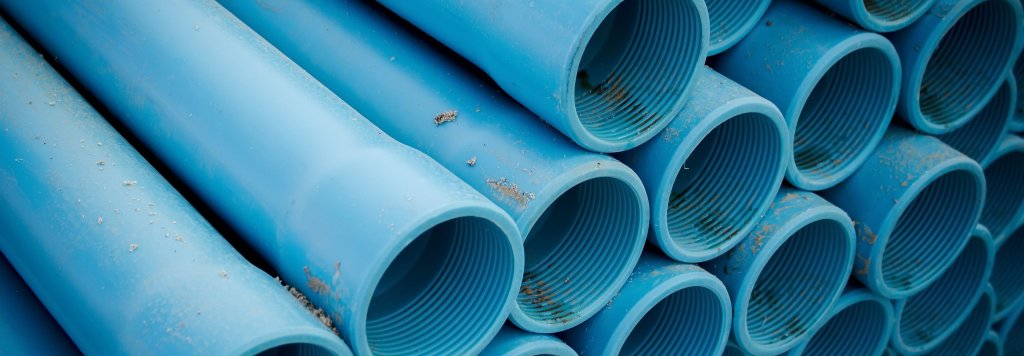Plastic drainage systems have gained popularity due to their versatility, cost-effectiveness, and resistance to corrosion. These systems are widely used in commercial buildings, industrial settings, and residential areas because they offer a practical wastewater and stormwater management solution.
Unlike traditional materials such as metal or concrete, plastic drainage components are lightweight, making them easier to install and maintain over time.


An Expert is just around the corner.
With over 100 years of combined product knowledge and industry experience, we are confident our plastics experts can help you find a solution for your application.
Different Types of Plastic Drainage Pipes
Plastic drainage systems come in various materials, each designed for specific applications. Below are common types and their key features:
Polyvinyl Chloride (PVC): Durable, lightweight, and resistant to chemical corrosion, making it a popular choice for drainage systems.
Chlorinated Polyvinyl Chloride (CPVC): Similar to PVC but with added heat resistance, ideal for hot and cold water lines.
Acrylonitrile Butadiene Styrene (ABS): Highly resistant to weather conditions, making it a reliable choice for outdoor drainage.
High-density polyethylene (HDPE): Strong and flexible, commonly used in underground drainage and industrial waste systems.
Why Plastic Drainage Systems Are a Smart Choice
The growing preference for plastic drainage systems can be attributed to several key advantages. First and foremost, plastic pipes are incredibly lightweight, which simplifies transportation and installation. Unlike heavy metal or concrete pipes, plastic pipes can be maneuvered easily without the need for specialized equipment, reducing labor costs and installation time.
Another major benefit is their resistance to corrosion and chemical exposure. Metal pipes are prone to rust, especially in environments where wastewater contains aggressive chemicals. Plastic pipes, however, do not degrade under these conditions, ensuring long-term reliability and reduced maintenance.
Another reason plastic drainage systems are widely used is their affordability. Plastic pipes are significantly more cost-effective than metal and concrete alternatives, allowing for large-scale installations without exceeding budget constraints. Additionally, plastic materials offer flexibility in design, with options such as pre-sloped trench drains and modular systems that can be tailored to specific site requirements.
Possible Concerns
While plastic drainage systems offer numerous benefits, they do have limitations. One of the primary concerns is their sensitivity to ultraviolet (UV) exposure. Certain types of plastic, such as PEX and PVC, can deteriorate when exposed to direct sunlight over extended periods, making them less suitable for above-ground outdoor applications.
Heat resistance is another factor to consider. Not all plastic pipes can withstand high temperatures, so CPVC is often preferred for hot water applications. Additionally, while plastic is generally durable, high-stress environments may require reinforced plastic or alternative materials to ensure long-term performance.
Where Plastic Drainage Systems Work Best
Plastic drainage systems are versatile and effective in various settings, offering reliable solutions for different drainage needs. They are commonly used in the following areas:
-
Commercial buildings
Efficiently manage wastewater from restrooms, kitchens, and mechanical rooms.
-
Residential properties
Help with stormwater management, gutter systems, and underground drain pipes.
-
Industrial applications
HDPE and reinforced plastic pipes transport chemical waste and handle high-pressure conditions.
-
Outdoor drainage
ABS and HDPE pipes are extremely weather-resistant, making them ideal for rainwater runoff and landscaping drainage systems.
Plastic Drainage Innovations
Advances in plastic technology continue to improve drainage systems' efficiency and sustainability. Manufacturers are developing eco-friendly alternatives that incorporate recyclable materials to reduce environmental impact. Additionally, reinforced plastic pipes and composite materials are being introduced to enhance durability and performance in high-stress environments.
Another innovation includes self-cleaning drainage systems with integrated flushing mechanisms to minimize blockages and reduce maintenance efforts. Plastic drainage systems will evolve as technology progresses, offering even greater efficiency, longevity, and environmental benefits.
Comparing Plastic Drainage with Other Materials
When selecting a drainage system, it's crucial to compare plastic pipes with traditional materials like metal and concrete to determine the best option for specific applications. Plastic drainage systems are often favored due to their durability, ease of installation, and cost-effectiveness. Unlike metal and concrete, plastic pipes offer long-term reliability with minimal maintenance.
Here’s how they compare:
Plastic vs. Metal
Plastic pipes are lightweight, rust-resistant, and affordable. While metal pipes provide extra strength, they are prone to corrosion, require protective coatings, and demand regular maintenance to prevent leaks and structural degradation.
Plastic vs. Concrete
Concrete pipes excel in extreme conditions due to their high strength, but they are heavy, difficult to install, and costly to transport. Plastic drainage systems, in contrast, are flexible, easy to manage, and allow for quick modifications and repairs with minimal labor and downtime.
Overall Advantages of Plastic
With superior chemical resistance, longevity, and lower installation costs, plastic drainage systems are an efficient and adaptable solution for residential, commercial, and industrial applications.
Need Expert Guidance?
Plastic drainage systems have reformed wastewater and stormwater management in commercial and residential applications. Their lightweight design, resistance to corrosion, and cost-effectiveness make them a preferred choice for many industries. While considerations such as UV sensitivity and heat resistance exist, the benefits far outweigh the drawbacks for most applications.
Learn More
Plastic drainage systems will remain a crucial part of modern infrastructure with ongoing advancements in material science, providing reliable and sustainable solutions for years. If you need plastic material for your plastic drainage system, contact our team today!
Send Us A Message

